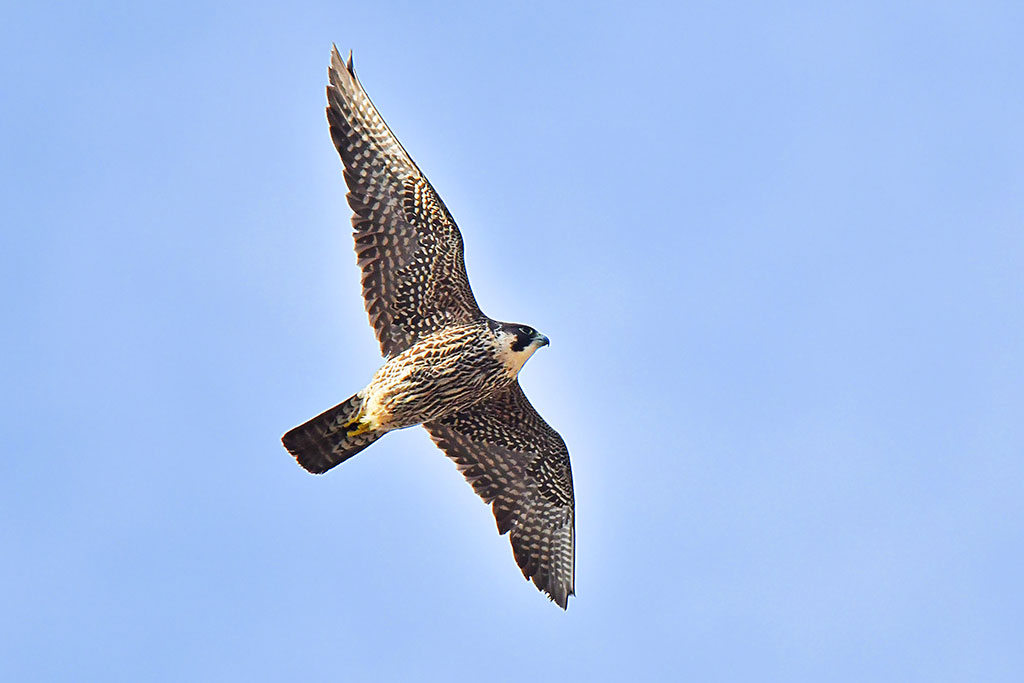North Carolina has some of the most iconic rock climbing in the Southern Appalachians, with mountains punctuated by granite domes and tall, gray cliffs rising from the edge of rivers. And every year, several of those cliffs are closed because of peregrine falcon nesting activity. The birds of prey are a recovering species, with numbers hovering in the low teens in North Carolina. To help promote healthy nesting in the state, the U.S. Forest Service and North Carolina Wildlife Resources Commission close nine different rock faces in Pisgah and Nantahala National Forests to climbing, rappelling and hang gliding from mid-January through August 15. But this year, the agencies lifted the climbing bans on all cliffs within North Carolina’s National Forests a month early in July. Some of the sites saw an early nesting and successful fledgling of the young birds, while other nests failed to produce healthy birds.
“If the birds can get their business done, we lift the closures early,” says Sheryl Bryan, a wildlife biologist with NC National Forests. “We have a great working relationship with the climbing community, and we understand that these cliffs are magnets for recreation.”
Peregrine falcons are impressive beasts. They’re one of the largest falcons in North America (adults are about 2 pounds with a 3-foot wingspan), feeding on medium-sized birds by striking at them in midair with speedy dives. City-dwelling peregrines love pigeons. Cliff-dwelling peregrines look for ducks and song birds. Peregrines are thought to reach dive speeds of up to 200 miles per hour when they’re hunting, making them the fastest birds in the world. The peregrine is found on all continents except for Antarctica—the most extensive natural distribution of any bird in the world. The falcons can thrive in most terrain except for truly high elevations, and yet to see a peregrine today is a rare treat, particularly in North America.

An adult peregrine falcon weighs about 2 pounds and has a 3-foot wingspan. (Photo Credit: Alan Lenk)
As hardy as the birds are, the falcons were no match for the widespread use of pesticides during the middle of the 20th century, and the species disappeared from most of its stomping grounds, earning a spot on the federal endangered species list. In North Carolina, the falcons dwindled to just one nesting pair by the ’50s. The North Carolina National Forests and North Carolina Wildlife Resources Commission have been actively working to restore populations of peregrines since the ’80s, and the species was removed from the federal list in 1999.
“We kept monitoring them after they were delisted and decided the population levels were better, but still not great,” says Sheryl Bryan, a wildlife biologist with North Carolina National Forests.
The North Carolina Wildlife Resources Commission estimates there are 13 nesting pairs of peregrines in the state. On public land, those pairs have set up nests on nine different cliffs, primarily in the mountains of Western North Carolina. A pair also nests in downtown Charlotte, and others on state forests and private property, mostly in the western part of the state. Peregrines are thought to mate for life and typically return to the same nest year after year, laying three to five eggs each mating season. If the peregrine’s nest is disturbed, the pair will abandon the area and won’t return until the next year. The most successful pairs of breeding falcons establish nests on remote cliffs away from potential intrusion. Fifty-five percent of the state’s peregrines mate and successfully raise young birds to be at least one month old, slightly less than the national average of 68 percent, according to the North Carolina Wildlife Resources Commission.
The cliff closures are an attempt to keep a physical and visual buffer between the nests and people. The Forest Service and the Commission issued the first cliff closures in 2004. The agencies evaluate the closure list annually, but it has largely remained the same over the years because of the repetitive nesting habits of the falcons. Some of North Carolina’s most cherished climbing destinations are on that closure list, including the North Face of Looking Glass Rock, the NC Wall in the Linville Gorge, the North Face of Cedar Rock, and Whiteside Mountain.
“Climbers are really respectful of the closures and of the birds too,” says Mike Reardon, a representative for the Carolina Climbers Coalition. “We want to see the peregrines succeed, but you also don’t want to be climbing next to them. Peregrines are fast birds who will protect their nests.”
Reardon is also the author of Southern Pisgah Rock and Ice, a new climbing guide book scheduled for release later this month that has several pages on peregrine falcons to help educate the public about the birds. The Forest Service will periodically lift the cliff closures early, and it’s always a welcome bit of news for the climbing community, particularly when the closures of Looking Glass and Cedar Rock are lifted.
“Both of those cliffs are great climbing in the summer because they’re so shady,” Reardon says. “When they open early, we’re psyched.”
This year, the North Carolina Wildlife Resource Commission estimates 16 young were produced from six successful nests across the state.
